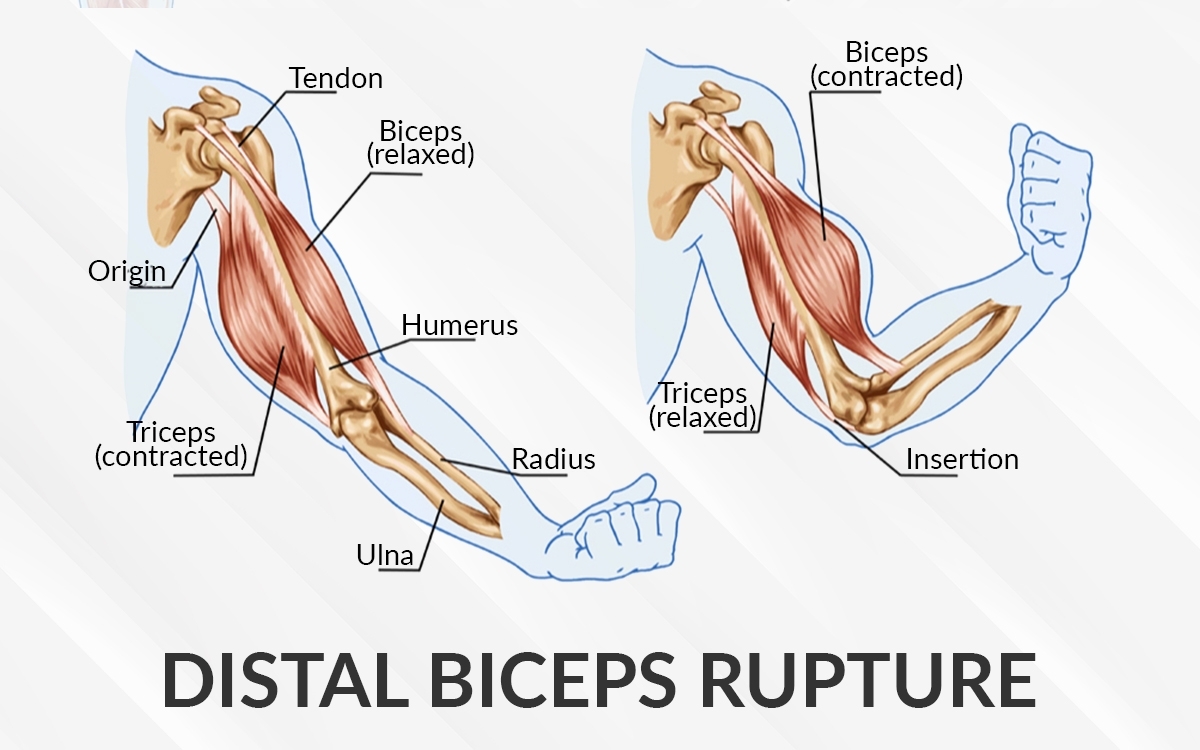
Summary
Causes
- Sudden Injury
- Steroid medications
- Smoking
Symptoms
- Swelling and bruising of elbow and forearm
- Weakness of supination and flexion
- Bulge of the upper arm
Diagnosis
- Gap in front of the elbow on physical examination
- Ultrasound scan or an MRI
Treatment
- In elderly patients
- Rest
- Pain killers
- Physiotherapy
- In young patients
- Surgery within first 3-4 weeks
What is Biceps muscle?
The biceps muscle is located in the front of your upper arm. It is attached to the shoulder and to the elbow with the help of two tendons. Near the elbow it is attached to a small bump on the radius bone (radial tuberosity). It normally helps to bend your elbow and to rotate your forearm (known as supination i.e. palm faces up to the ceiling)
Tears to the distal biceps tendon happen because of a sudden injury. This results in weakness to the arm and surgery is usually recommended in a younger age group to return the arm strength.
It usually happens in men in age group 30 to 50, common in weightlifters. Usual mechanism is; elbow is forced straight against a resistance for example lifting a heavy weight or a heavy box. Further risk factors for distal biceps tendon tear include smoking and steroid medications.
What are the symptoms of Distal Biceps Tendon Rupture?
Often patients say that they heard a pop at the elbow. There will be swelling and bruising of the elbow and forearm, along with weakness of supination of around 50% and weakness in flexion of the elbow around 20%. This will be associated with a bulge of the upper arm (reverse popeye)
How is Distal Biceps Tendon Rupture diagnosed?
The doctor will discuss the mechanism of the injury and your symptoms and on examination will look for a gap in the front of the elbow. To further confirm the clinical diagnosis the doctor may ask for an ultrasound scan or sometimes an MRI scan.
Treatment for Distal Biceps Tendon Rupture?
In elderly patients that do not require a full on function, this can be managed non-operatively with rest, pain killers and physiotherapy to strengthen the surrounding muscles.
In young patients surgery is recommended. Ideally it should be done within the first 3 to 4 weeks as after this time the muscle and tendon may shorten and make surgery difficult.
What happens during the operation?
The main aim is to reattach the tendon to the forearm bone. This is normally done as a day case under a general anaesthetic.
Surgery involves making a longitudinal cut in the front of the elbow. Sutures are passed through the tendon and then tendon is reattached to the bone using an endobutton. At the end of the operation the wound is stitched with absorbable sutures. You will come out in a plaster or an elbow brace. You will be discharged home on the same day as surgery. Operation will take approximately 1 to 2 hours.
What happens after the procedure?
Following the surgery you will be taken to the recovery department. Once the anaesthetic wears off ; you will go home the same day. Keep the wound dry for 2 weeks, you will then be seen in clinic in 2 weeks’ time for a wound check where further physiotherapy will be discussed and you will be seen by a physiotherapist. It takes roughly 10 weeks for the tendon to join to the bone. It is advisable to avoid any heavy lifting or contact sports for 4-6 months.
What are the risks?
This operation has a good predictable outcome with very few surgical complications which are usually temporary.
Numbness can happen in the forearm or on the thumb side of the wrist which is temporary and usually settles down within 3 months.
Very occasionally new bone can form at the site of attachment of tendon to the forearm. Usually this does not cause any limitation to the function. Very occasionally, if the bone formation is a lot then additional surgery may be needed to remove it.
Injury to one of the nerves in this area can cause limitation of finger movements which usually resolve in 3-6 months.
What can I expect in terms of outcome?
You can expect almost full range of motion and strength at around 6 months. At around 4-6 months you can go back to the jobs that involve heavy manual labour, heavy lifting or contact sports.
BMI Chelsfield Park Hospital
Bucks Cross Road Chelsfield ORPINGTON BR6 7RG
01689 877855
BMI The Blackheath Hospital
40-42 Lee Terrace Blackheath LONDON SE3 9UD
020 8318 7722
BMI The Sloane Hospital
125 Albemarle Road BECKENHAM BR3 5HS
020 8466 4000
Princess Royal University Hospital
Farnborough Common ORPINGTON BR6 8ND
01689 863223



